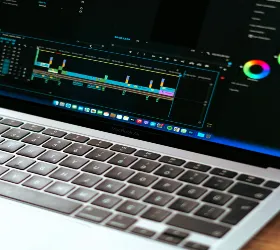What Is B-Roll in Video Editing (2025)
What is B-Roll?
B-roll footage is additional footage that complements the main footage, referred to as A-roll. A-roll is your primary video footage; it could be someone speaking directly to the camera. B-roll is additional footage that adds context or emotion to the viewer. B-roll is important because it keeps the viewer engaged. It adds context to the action and keeps your viewer from getting bored.
For example, if you are filming a video blog talking about video editing software, where A-roll would be you explaining what the tools do, then B-roll could be screenshots of you using the software program, close-ups of your hands editing short clips, and even your facial reactions!
Why B-Roll is Important in 2025
Why B-Roll is Important in 2025. More visual requirements: Users demand dynamic visual storytelling due to the rise of TikTok and YouTube Shorts. B-roll footage adds pace and polish to your edited videos.
- Increase engagement: Videos that have interesting, creative B-roll and editing are more likely to retain viewer engagement for longer time periods. Watch time is critical for SEO and algorithm placement.
- Improve clarity: B-roll is a visual representation of or clarity to what you are saying. Instead of talking about a product, show the product in action.
- Increase buyer confidence: B-roll that has been shot well will have a professionalism to it, which will increase viewer confidence in your brand or blog.
B-Roll categories in 2025.
Here are the most popular types of B-roll content that creators use today:
- Contextual B-Roll: Footage that shows someone doing whatever it is they normally do in their space – i.e., a video editor’s work desk.
- Cutaway Shots: Related shots that are cut in quickly – i.e,. a clip of a computer screen or a shot of the timeline in Premiere Pro while talking about how to edit.
- Establishing Shots: Are used at the beginning of a scene to establish where it is located. Reaction Shots: This is a shot of a person’s face or the audience’s response along with the video to help give emotion to the piece.
- Product Close-Ups: Tight shots that showcase the tools or items you are talking about.
How to get Better Quality B-Roll in 2025
- Plan Ahead: Include your B-roll shots in your script or storyboard – think of it this way: “What visual supports this statement?”
- Use a Shot List: Make a checklist of B-roll angles and scenes you want to capture in your shoot so that you don’t miss anything.
- Keep it still: Use tripods or gimbals to stabilize your footage.
- Use AI Tools: Tools like Adobe Premiere Pro (with Sensei AI) and Descript can now suggest B-roll inserts based on your script.
- Record More B-Roll than You Think You Need: You never know what will be useful when you are in the edit.
The Process of Cutting B-Roll into Your Videos
- Overlay: Layer B-roll clips on the timeline directly under your main video A-roll so that it sits on top without disturbing the audio.
- Cut-In & Jump Cut: Utilize B-Roll to cover jump cuts or amplifications.
- Timing: Use the exact words or phrases in the dialogue whenever possible to increase the flow and impact of your editing.
- Use Transitions Sparingly: Less is always more. You don’t need fancy transitions when your content is so great.
New Tools to Add B-Roll Starting in 2025
- RunawayML: An AI video clip editing tool that will also suggest and enhance your B-Roll.
- Pictory: B-roll is automatically generated from your script/blog post.
- Storyblocks & Artgrid: royalty-free, but you can source higher-quality B-Roll.
- CapCut & VN: mobile editing can quickly cut your B-roll on the go.
B-Roll Across Different Platforms
| Platform | Best B-Roll Uses |
| YouTube | Explanations, tutorials, and reviews |
| Instagram Reels | Behind-the-scenes, product close-ups |
| TikTok | Reaction shots and transitions |
| Blog Companion Video | Screencasts and storytelling shots |
Optimizing B-Roll for SEO and Clicks:
- Align it with Keywords: Use the B-roll that aligns with your video’s main SEO keyword (e.g., “video editing in 2025″).
- Add Captions: B-roll with captions makes content more accessible and increases content retention.
- B-Roll Action Photos as Engaging Thumbnails: Use action shots rather than the talking heads.
- Repurpose B-Roll: Take snippets of your video B-Roll and use them as Instagram Stories, YouTube shorts, or blog gifs.
Common B-Roll Pitfalls:
- Using Too Many Stock Footage Clips: It makes your video feel generic.
- Unrelated Clips: The viewer loses context, and it dilutes your main message.
- Too Dark or Choppy Footage: This can detract from a polished look.
- Not fitting the narrative: You should always ask, Does this clip serve the story?
Conclusion
To summarize, B-roll is not just a visual placeholder, but rather a storytelling asset that every content creator must learn about in 2025. B-roll can help clarify your message, increase audience retention time, help your videos SEO ranking, and create a more engaging feel that separates you from the pack.
Whether you’re creating a vlog, tutorial video, or product review, adding purposeful B-roll can elevate your content from good to viral. So, organize your shoots, take that camera out, shoot some B-roll, and your audience (and traffic) will appreciate it. Want to Learn More?
- 💡 Join our newsletter for weekly video editing tips.
- 🎬 Enroll in our B-Roll Mastery course for an extensive training program for the best B-roll in 2025!
- 📸 Follow us on Instagram and YouTube for strategies and samples!
Frequently Ask Questations
B-roll is extra footage in video post-production to complement the primary content (A-roll). B-roll helps to visually demonstrate what is being said, add context, variance, pacing, and secondary elements to tell a compelling story.
In 2025, B-roll is important to increase audience viewing retention by alleviating the repetitiveness in your content, creating visual interest, and supporting your content in an SEO-based content creation world on platforms like YouTube Shorts, Instagram Reels, and blog video content.
The most impactful B-Roll in 2025: contextual clips, product close-ups, drone shots, screen recordings, reaction shots – and also leveraging AI-generated visuals in tutorials, reviews, or storytelling.
Absolutely! In 2025, AI tools, like Runway ML, Pictory, and Adobe’s Sensei, offer suggestions or automatically generate any B-roll based on a script or blog post, providing video creators a quicker and smarter way to create engaging visual content
You can shoot or make libraries of your B-roll, or reach for the best royalty-free libraries, like Artgrid, Pexels, Storyblocks, or Canva Video. In 2025, AI tools that provide B-Roll clips based on topics and niches expand into auto-generating and enhancing B-Roll clips.









